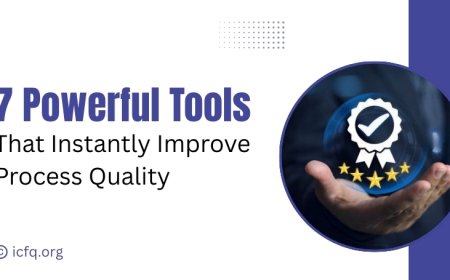Becoming an Expert in Six Sigma Black Belt Techniques
Learn how to improve processes and manage quality effectively with Six Sigma Black Belt expertise. Achieve success in your organization.

Companies always want to make their processes better, fix any mistakes, and work more efficiently. That's where Six Sigma comes in. It's a way of making things almost perfect by finding and fixing any problems in how things are done. If you want to be an expert at Six Sigma, getting a Black Belt certification is a big deal. Black Belts are like the leaders of improvement projects. They know a lot and can lead teams to make big changes in a company. First, you need to understand Six Sigma well. This means knowing about things like DMAIC (Define, Measure, Analyze, Improve, Control) and DFSS (Design for Six Sigma). Some courses can teach you all about these concepts and how to use them in different industries and jobs. Getting certified in Six Sigma is also really important. This shows that you know your stuff and can use Six Sigma to make things better. Some courses even let you practice what you've learned with real-life examples and projects. Lean Six Sigma courses are great because they combine Six Sigma with Lean manufacturing, which is all about getting rid of waste.
Nowadays, you can learn Six Sigma online, which makes it easier for a lot of people. You can study whenever you want and from wherever you are. This has made it possible for people all over the world to become Six Sigma Black Belts. As you go through the different levels of Six Sigma certification, from Yellow Belt to Green Belt, and finally to Black Belt, you'll learn more and more advanced skills. By the time you become a Black Belt, you'll be ready to lead big projects and make a real difference in your company.
Learning Advanced Techniques for Improvement
When you're trying to become a Six Sigma Black Belt, you start with learning about Six Sigma Green Belt stuff. This is like step one. Then, you move up to the Black Belt level, which is a big deal because it means you're super good at it. To get there, you have to learn a bunch of math and tools for solving problems, plus how to manage projects and work well with others. But even after you get certified, you still have to keep learning and using what you know to help fix things in the real world. But getting good at Six Sigma isn't easy. You face tough problems that need smart solutions. You have to be good at thinking ahead and understanding how different parts of a business fit together. And you also need to be able to work with all kinds of people and understand how they think. Trying to be a Six Sigma Black Belt is all about showing that you're dedicated to doing your best and helping your company do better too. When you become a Black Belt, you're not just boosting your career, you're also helping make your workplace a better, more successful, and competitive environment.
Tackling the Challenges of Becoming a Six Sigma Black Belt
Becoming a Six Sigma Black Belt means diving into a journey of mastering processes to make organizations better. But along with the excitement of getting this top-notch certification, there are many tricky parts to tackle. Let's break down the tough stuff waiting for anyone aiming for that prestigious Six Sigma Black Belt:
-
Complicated Tools: Six Sigma is filled with lots of tricky tools and methods, like stats and tests. Getting good at these methods takes a lot of time and hard work. It's tough for many people, and it needs real dedication.
-
Getting Everyone on Board: Bringing Six Sigma into a company can be hard. Some folks might not like it because they're used to doing things a certain way. Getting them to see the benefits and working through office politics needs good communication and negotiation skills.
-
Changing the Way Things Work: Six Sigma isn't just about using tools; it's about changing how people think and act in a company. Getting folks to do things differently needs patience and being smart. Some people might not like change, so you have to handle that well.
-
Not Enough Resources: Doing Six Sigma projects needs a lot of stuff like time, money, and people. If you don't have enough, it can be hard to get things done right. Figuring out how to use what you have in the best way is super important.
-
Project Problems: Six Sigma projects can run into all sorts of problems, like taking too long or not involving the right people. Making sure things stay on track and everyone stays happy needs good project management skills.
-
Keeping the Ball Rolling: Getting that Six Sigma Black Belt isn't the end; it's just the beginning. Keeping things going and making sure everyone stays focused on getting better is a big job. Making sure everyone feels responsible and wants to help is key.
Want to become good at Six Sigma Black Belt techniques?
Becoming an ace at Six Sigma Black Belt techniques takes some work but it's doable. First off, you'll need to get some training from places like the American Society for Quality (ASQ) or the International Association for Six Sigma Certification (IASSC). They'll teach you all the important stuff like stats, process improvement, and how to manage projects, all tailored for Black Belt folks like yourself. Next, you gotta put that knowledge to use. Try working on projects within your company or find chances to get involved in Six Sigma projects. That hands-on experience is super important. And hey, keep learning! Stay up to date on what's happening in the industry so you can keep getting better at Six Sigma. Keep at it, and you'll master those Black Belt techniques in no time.

Becoming a Six Sigma Black Belt Techniques
Becoming a Six Sigma Black Belt isn't just about getting a fancy certificate; it's about becoming good at making things work better in a company. Here's what you need to know to become a master at it:
1. Getting Good at the Basics: To become a Six Sigma Black Belt master, you have to understand the basic ideas and tools well. This means knowing stuff like DMAIC (Define, Measure, Analyze, Improve, Control), using statistics to understand problems, and drawing out how processes work. Once you've got these basics down, you're ready to move on to more advanced stuff.
2. Always Learning and Getting Better: Getting the Black Belt is just the start. You have to keep learning to stay good at it. That means taking more classes, going to workshops and meetings, and finding ways to get even better at what you do.
3. Putting Ideas into Action: It's not enough to just know things—you have to use them. Being a Black Belt means working on real projects in your company, using what you know to make things run smoother and better.
4. Being a Good Leader and Communicator: Since Black Belts often lead teams and talk to lots of different people, you have to be good at leading and talking. That means being able to run meetings, explain things well, and get people excited about making changes.
5. Making Improvement a Big Deal: Being a Black Belt isn't just about fixing one thing—it's about making the whole company better. That means getting everyone to think about how they can make things better all the time.
6. Always Trying to Be Better: Being a master isn't something you finish—it's something you keep working on. Black Belts should always try to do more, like getting more certificates, teaching others, and working on harder projects.
Learning Six Sigma Black Belt techniques is a smart move for both you and your company. By going through thorough training and putting what you learn into practice, you'll get good at improving processes, solving problems, and making things work better overall. Getting certified as a Six Sigma Black Belt doesn't just show you know your stuff, it shows you're committed to always making things better and keeping quality high. When you use data to make decisions and follow the DMAIC steps, you'll become a leader in making positive changes that make things run smoother, work better, and lead to long-term success in today's competitive world.



























